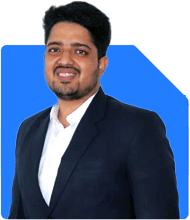Ramalingam Kalirajan |10905 Answers |Ask -Follow
Mutual Funds, Financial Planning Expert - Answered on Jul 04, 2024
He has an MBA in finance from the University of Madras and is a certified financial planner.
He is the director and chief financial planner at Holistic Investment, a Chennai-based firm that offers financial planning and wealth management advice.... more

I am 45 in a pvt job. I want to invest in SIP for a period of 5 yrs to get good returns by the end of 10 yrs. My risk appetite is moderate. I need to plan for my 2 children studies, their wedding and my retirement. 4 sips of Rs. 3000 is doable for me.
Understanding Your Financial Goals
Children’s Education and Weddings
Education expenses are significant and can increase over time. Weddings are also major financial commitments. You need investments that grow steadily.
Retirement Planning
Retirement planning requires a balance of growth and stability. You need to ensure you have enough funds to sustain your lifestyle.
The Benefits of SIPs
Disciplined Investing
SIPs encourage regular investing. This discipline is crucial for long-term wealth creation.
Rupee Cost Averaging
SIPs help in averaging the purchase cost of mutual funds over time. This reduces the impact of market volatility.
Compounding Power
Investing regularly and staying invested helps in compounding returns. The longer you stay invested, the more your money grows.
Allocating Your Investments
Let's explore how to allocate Rs. 3,000 in each of the 4 SIPs. Given your moderate risk appetite, we'll focus on a mix of equity and hybrid funds.
Equity Mutual Funds
Large-Cap Funds
Large-cap funds invest in well-established companies with a proven track record. They offer stability and reasonable returns.
Mid-Cap Funds
Mid-cap funds invest in medium-sized companies. They offer a balance of growth potential and risk.
Advantages of Equity Funds
Growth Potential: Equity funds have the potential for high returns.
Inflation Protection: They help in beating inflation over the long term.
Liquidity: Easy to redeem when needed.
Risks of Equity Funds
Market Volatility: Returns can fluctuate based on market conditions.
Investment Horizon: Requires a longer investment horizon for significant returns.
Hybrid Mutual Funds
Balanced Advantage Funds
These funds invest in a mix of equity and debt. They offer stability with the potential for growth.
Multi-Asset Allocation Funds
These funds invest in multiple asset classes like equity, debt, and gold. They provide diversification and balanced risk.
Advantages of Hybrid Funds
Diversification: Invest in a mix of asset classes.
Moderate Risk: Balance between growth and stability.
Flexibility: Fund managers can adjust the asset allocation based on market conditions.
Risks of Hybrid Funds
Lower Returns: Compared to pure equity funds, returns may be lower.
Management Risk: Fund managers' decisions impact performance.
Suggested SIP Allocation
Given your investment horizon and moderate risk appetite, here’s a suggested allocation:
SIP 1: Large-Cap Fund
Invest Rs. 3,000 in a large-cap fund. These funds offer stability and consistent returns, making them ideal for long-term goals like retirement.
SIP 2: Mid-Cap Fund
Invest Rs. 3,000 in a mid-cap fund. These funds provide a good balance of growth potential and risk, suitable for children's education and wedding expenses.
SIP 3: Balanced Advantage Fund
Invest Rs. 3,000 in a balanced advantage fund. These funds offer a mix of equity and debt, providing moderate risk and stable returns.
SIP 4: Multi-Asset Allocation Fund
Invest Rs. 3,000 in a multi-asset allocation fund. These funds provide diversification across multiple asset classes, balancing risk and returns.
Monitoring and Adjusting Your Portfolio
Regular Reviews
Review your portfolio every six months. Assess the performance of each fund and make adjustments if needed.
Annual Rebalancing
Rebalance your portfolio annually. Ensure your investments align with your financial goals and risk tolerance.
Staying Informed
Stay updated with market trends and economic conditions. This helps in making informed decisions about your investments.
The Power of Compounding
Long-Term Growth
Investing regularly through SIPs harnesses the power of compounding. Your investments grow over time, providing substantial returns.
Example
If you invest Rs. 3,000 in each SIP for 5 years, your total investment is Rs. 7,20,000. With compounding, this amount can grow significantly over the next 10 years.
Disadvantages of Direct Funds
Lack of Guidance
Investing directly without a Certified Financial Planner (CFP) means you miss out on professional advice. This can lead to poor investment choices.
Time-Consuming
Managing direct investments requires time and effort to research and monitor.
Emotional Decisions
Without professional guidance, you might make impulsive decisions during market volatility.
Benefits of Investing through MFD with CFP
Personalized Advice
A Certified Financial Planner (CFP) offers personalized advice tailored to your financial goals.
Professional Management
CFPs provide ongoing management and review of your portfolio.
Peace of Mind
Having a professional manage your investments reduces stress and ensures you stay on track.
Tax Planning
Tax Benefits of SIPs
Investing in Equity Linked Savings Schemes (ELSS) offers tax benefits under Section 80C. Consider allocating a part of your investment to ELSS for tax savings.
Tax on Capital Gains
Be aware of the tax implications on capital gains. Long-term capital gains (LTCG) tax applies after holding the investment for over a year.
Insurance and Emergency Fund
Life Insurance
Ensure you have adequate life insurance coverage. This provides financial security to your family in case of unforeseen events.
Health Insurance
Invest in a comprehensive health insurance policy. This covers medical expenses and safeguards your savings.
Emergency Fund
Maintain an emergency fund equal to 6-12 months of your expenses. This provides a financial cushion during unexpected situations.
Final Insights
Starting your SIP investment journey with a clear plan and diversified approach is commendable. By allocating Rs. 3,000 in each of the 4 SIPs across large-cap, mid-cap, balanced advantage, and multi-asset allocation funds, you balance growth potential with stability.
Regular monitoring, rebalancing, and staying informed ensures you stay on track to achieve your long-term financial goals. Investing through a Certified Financial Planner provides personalized advice and professional management, enhancing your investment experience.
Your disciplined approach and strategic planning will lead to a secure financial future. Stay committed, stay informed, and keep your long-term goals in sight.
Best Regards,
K. Ramalingam, MBA, CFP,
Chief Financial Planner,
www.holisticinvestment.in
You may like to see similar questions and answers below
Nikunj Saraf | Answer |Ask -Follow
Mutual Funds Expert - Answered on May 22, 2023
Ramalingam Kalirajan |10905 Answers |Ask -Follow
Mutual Funds, Financial Planning Expert - Answered on Apr 23, 2024
Ramalingam Kalirajan |10905 Answers |Ask -Follow
Mutual Funds, Financial Planning Expert - Answered on Jul 18, 2024
Milind Vadjikar | Answer |Ask -Follow
Insurance, Stocks, MF, PF Expert - Answered on Oct 10, 2024
Ramalingam Kalirajan |10905 Answers |Ask -Follow
Mutual Funds, Financial Planning Expert - Answered on Aug 01, 2025
Ramalingam Kalirajan |10905 Answers |Ask -Follow
Mutual Funds, Financial Planning Expert - Answered on Dec 19, 2025
Ramalingam Kalirajan |10905 Answers |Ask -Follow
Mutual Funds, Financial Planning Expert - Answered on Dec 19, 2025
Ramalingam Kalirajan |10905 Answers |Ask -Follow
Mutual Funds, Financial Planning Expert - Answered on Dec 19, 2025
Radheshyam Zanwar |6751 Answers |Ask -Follow
MHT-CET, IIT-JEE, NEET-UG Expert - Answered on Dec 19, 2025
Radheshyam Zanwar |6751 Answers |Ask -Follow
MHT-CET, IIT-JEE, NEET-UG Expert - Answered on Dec 19, 2025
Samraat Jadhav |2514 Answers |Ask -Follow
Stock Market Expert - Answered on Dec 18, 2025
Reetika Sharma |432 Answers |Ask -Follow
Financial Planner, MF and Insurance Expert - Answered on Dec 18, 2025
Reetika Sharma |432 Answers |Ask -Follow
Financial Planner, MF and Insurance Expert - Answered on Dec 18, 2025
Reetika Sharma |432 Answers |Ask -Follow
Financial Planner, MF and Insurance Expert - Answered on Dec 18, 2025
Samraat Jadhav |2514 Answers |Ask -Follow
Stock Market Expert - Answered on Dec 18, 2025






















